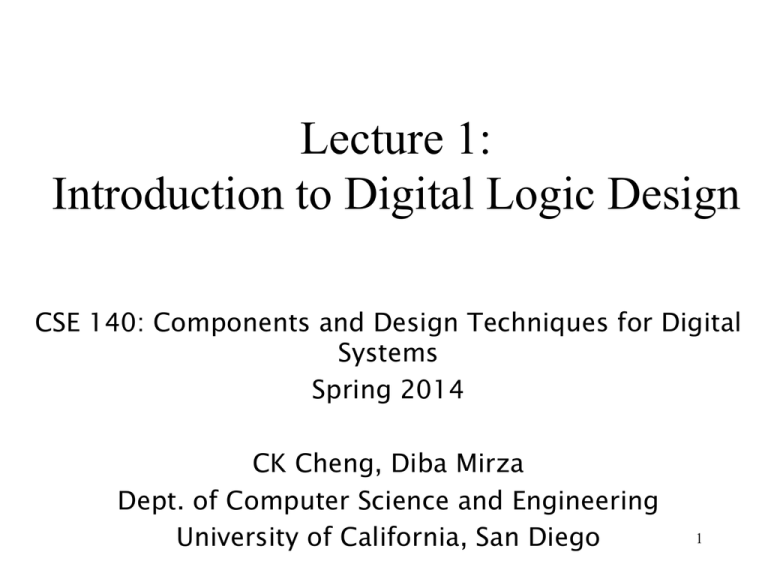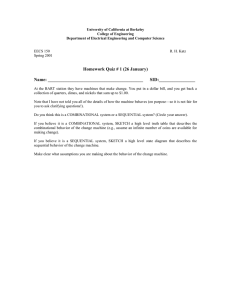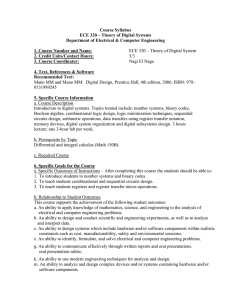Lecture 1: Introduction to Digital Logic Design
advertisement

Lecture 1: Introduction to Digital Logic Design CSE 140: Components and Design Techniques for Digital Systems Spring 2014 CK Cheng, Diba Mirza Dept. of Computer Science and Engineering University of California, San Diego 1 Information about the Instructor • • • • • Instructor: CK Cheng Education: Ph.D. in EECS UC Berkeley Office: 2130 EBU3B Email: ckcheng+140@ucsd.edu Office hours: CSE2130 – 1:30-2:20PM, T – 10:30-11:20AM, Th 2 Information about the Instructor • Instructor: Diba Mirza • Education: M.S., Ph.D. in Electrical and Computer Engineering (UCSD) • Office: 2124 EBU3B • Email: dimirza@eng.ucsd.edu • Office hours: – M 10:30am- 11:30 am, T 11am –noon – Or by appointment 3 Information about TAs *TAs shared between sections A and B • • • • • • • • • Krithika Singh Vineel Pratap Konduru Xiao Liu Alireza Khodamoradi Anup Chenthamarakshan Yichi Zhang Dao Dinh Lam Vidya Kirupanidhi Jongchyi Su Office hours and emails available on the course website4 Logistics: Resources All information about the class is on the class website: http://cseweb.ucsd.edu/classes/sp14/cse140-b/index.html • Approx. Syllabus • Detailed schedule • Readings • Assignments • Grading policy • Forum (TED) • Content/announcements through TED *make sure you have access I will assume that you check these daily 5 • Grades will be posted on Grade Source Logistics: Textbooks Required text: • [Harris] Digital Design and Computer Architecture, D.M. Harris and S.L. Harris, Morgan Kaufmann, 2013 (2nd Edition). Other references: • [Palmer] Introduction to Digital Systems, J. Palmer and D. Perlman, Schaum's ouTlines, 1993. • [Lang]: “Digital Systems and Hardware/Firmware Algorithms” by Milos D. Ercegovac and Tomas Lang 6 In class we will use Clickers! • Lets you vote on multiple choice questions in real time. 7 Lecture: Peer Instruction • I will pose carefully designed questions. You will – Solo vote: Think for yourself and select answer – Discuss: Analyze problem in teams of three • Practice analyzing, talking about challenging concepts • Reach consensus • If you have questions, raise your hand and I will come over – Group vote: Everyone in group votes – Class wide discussion: • Led by YOU (students) – tell us what you talked about in discussion that everyone should know! 8 Why Peer Instruction? • You get to make sure you are following the lecture. • I get feedback as to what you understand. • It’s less boring! • Research shows it promotes more learning than standard lecture. 9 Logistics: Course Components Grading (grade on style, completeness and correctness) • iClicker: 3% (12 out of 15 classes) • Homework: 7% (grade based on a subset of problems. If more than 70% of class fills CAPEs, best 4 out of 5 ) • Midterm 1: 30% (T 4/22) • Midterm 2: 30% (T 5/13) • Midterm 3: 30% (Th 6/05) • Optional take home final exam due 10PM, Th 6/12: 1% bonus • Grading: Absolute: A->90% , pass (C-)> 40% pass We will consider the curve. 10 A word on HWs and exams • HWs: – Practice for exams – Do them individually for best results • Exams • (Another) Indication of how well you have absorbed the material • View exam results as objectively as possible • Learn from mistakes and move on …. 11 Course Problems…Cheating • What is cheating? – Studying together in groups is encouraged – Turned-in work must be completely your own. – Copying someone else’s solution on a HW or exam is cheating – Both “giver” and “receiver” are equally culpable • Cheating on HW/ exams: in most cases, F in the course. • Any instance of cheating will be referred to Academic Integrity Office 12 Motivation • Microelectronic technologies have revolutionized our world: cell phones, internet, rapid advances in medicine, etc. • The semiconductor industry has grown from $21 billion in 1985 to $268 billion in 2007. 13 The Digital Revolution Integrated Circuit: Many digital operations on the same material Vacuum tubes Exponential Growth of Computation (1.6 x 11.1 mm) ENIAC WWII Integrated Circuit Stored Program Model 1949 Moore’s Law 1965 14 Robert Noyce, 1927 - 1990 • Nicknamed “Mayor of Silicon Valley” • Cofounded Fairchild Semiconductor in 1957 • Cofounded Intel in 1968 • Co-invented the integrated circuit 15 Gordon Moore • Cofounded Intel in 1968 with Robert Noyce. • Moore’s Law: the number of transistors on a computer chip doubles every 1.5 years (observed in 1965) 16 Technology Trends: Moore’s Law • Since 1975, transistor counts have doubled every two years. 17 Principle of Abstraction CSE 141 CSE 140 Abstraction: Hiding details when they aren’t important focus of this course CSE 30 Application Software programs Operating Systems device drivers Architecture instructions registers Microarchitecture datapaths controllers Logic adders memories Digital Circuits AND gates NOT gates Analog Circuits amplifiers filters Devices transistors diodes Physics electrons 18 Scope • The purpose of this course is that we: – Learn the principles of digital design – Learn to systematically debug increasingly complex designs – Design and build digital systems – Learn what’s under the hood of an electronic component 19 We will cover four major things in this course: - Combinational Logic (Harris-Chap 2) - Sequential Networks (Harris-Chap 3) - Standard Modules (Harris-Chap 5) - System Design (Harris-Chap 4, 6-8) 20 Scope: Overall Picture of CS140 Data Path Subsystem Input Memory File Pointer Select Control Subsystem Conditions Sequential machine Mux ALU Memory Register Conditions Control CLK: Synchronizing Clock 21 Combinational Logic vs Sequential Network x1 . . . xn fi(x) Combinational logic: yi = fi(x1,..,xn) x1 . . . xn si fi(x) CLK Sequential Networks 1. Memory 2. Time Steps (Clock) yit = fi (x1t,…,xnt, s1t, …,smt) Sit+1 = gi(x1t,…,xnt, s1t,…,smt) 22 Scope Subjects Building Blocks Theory Combinational Logic AND, OR, NOT, XOR Boolean Algebra Sequential Network AND, OR, NOT, FF Finite State Machine Standard Modules Operators, Interconnects, Memory Data Paths, Control Paths Arithmetics, Universal Logic System Design Methodologies 23 Part I. Combinational Logic a b c d ab ab + cd e (ab+cd) cd e Next Lecture Reading: [Harris] Chapter 2, Section 2.1-2.4 24


